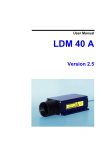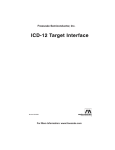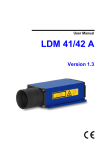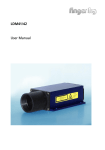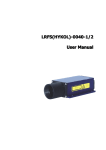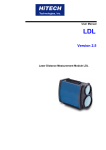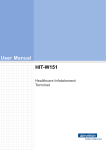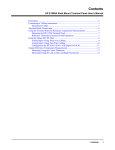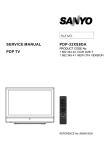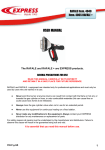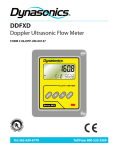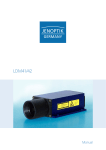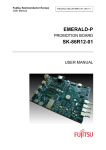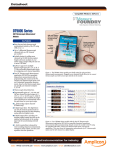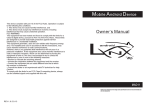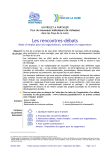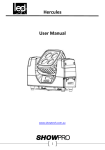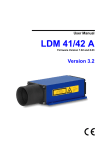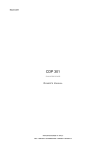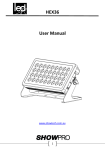Download LRFS-0040 User Manual
Transcript
Laser Distance Measuring Systems LRFS-0040 User Manual Dear User You are advised to read this User Manual carefully before you start using the LRFS-0040 laser distance measurement module. This is necessary to ensure that you will be able to utilize all the capabilities which your new acquisition provides. This technology is subject to continuously ongoing development. NOTE No part of this User Manual may be reproduced in any way (by print, photocopying, microfilm or any other technique) without prior written approval , nor may it be processed, duplicatedated or disseminated with the help of electronic systems. Appropriate care was used in compiling this document. No liability will be accepted in the event of damage resulting from a non-compliance of the information that is contained herein. Page 2 of 20 Table of Contents 1. 2. 3. 4. 5. 6. 7. 8. 9. 10. 11. 12. 13. General .................................................................................................................. 4 Safety Instructions .................................................................................................. 5 Performance Data ................................................................................................... 6 Working Principle .................................................................................................... 7 Setup ..................................................................................................................... 8 Interface Cable Wire Assignments ............................................................................ 9 Limiting Values for Voltages ....................................................................................10 Starting Up ............................................................................................................11 Parameters ............................................................................................................12 Functions ..............................................................................................................16 Transmission Protocol.............................................................................................18 Error Messages ......................................................................................................19 Service, Maintenance, Warranty ..............................................................................20 Page 3 of 20 1. General The LRFS-0040 laser distance measurement module is designed for mobile and stationary distance measurement. Particular features are: - Operation under extreme outdoor temperatures with high accuracy and great reach - Great range of operating voltages (10 V= to 30 V=) from on-board vehicle supply, a direct voltage industrial supply net or a DC power pack - Small stable power consumption <1.5 W (without IAlarm) - Up to 30 m reach for distance measurement, and more than 100 m reach with additional reflectors1 mounted onto target (depending on reflectance and environmental conditions) - Simple sighting with visible laser beam - Flexible extendible interface cable for voltage supply, bidirectional data interface, switching output and analog output - Input of commands for available measuring functions and output of measured readings via PC or laptop - Switching output and analog output are separately programmed and with different parameters - Positive and negative excession of distance is signalled with adjustable distance barrier at switching output - Measured values are displayed in meters, decimeters, centimeters, feet, inches, etc. due to free scaling - Option for remote triggering of measurement from external trigger device 1 3M, Typ 3270, 3290, 5290 Page 4 of 20 2. Safety Instructions These safety and operating instructions should be carefully read and followed during operation and handling of the LRFS-0040. There is danger from laser radiation or electrical shock! For repair work, the LRFS-0040 may not be opened by anyone other than Manufacturer personnel or expressly authorized and duly instructed persons. Please note that dangerous high voltage and laser radiation is present in the inner product space. Compliance with the prescribed operating conditions is necessary. Failure to observe advice or information contained herein or non-conforming usage of the LMCJ-0040 may cause physical injury to operating personnel or material damage to the measuring module. To operate the LRFS-0040, use only 10 V to 30 V direct voltage supply in all cases. Important operating advice To be able to fully utilize the system's capabilities, you should strictly follow these rules: - Do not operate the module if there is fogging or contamination on optical parts. - Do not touch the module's optical parts with bare hands. - Use caution when removing dust or soiling from optical components. - Prevent exposure to shock impacts during transportation and operation. - Prevent overheating of the module. Do not expose the module to direct sun radiation while it is stored in a motor vehicle. - The LRFS-0040 is splashproof and dustproof as required under IP 65 internal protection standards. - The LRFS-0040 laser distance measurement module is a class 2 laser product under DIN EN 60825-1:2001-11. Warning: There is class 2 laser radiation when the cover is removed. Do not look into the beam! Page 5 of 20 3. Performance Data Measuring range2: Measuring accuracy3: Meas. value resolution: Measuring rate5,6: Laser divergence8: Operating temperature9: Storage temperature: Supply voltage: Power consumption: Data interface10: Digital switching output: Analog output: Trigger input: Eye safety class: Wavelength: Dimensions (L x W x H): Weight: Internal protection class: 0.2 m to 50 m with natural surfaces, more than 100 m achievable depending on target reflectance ± 3 mm, ± 2 mm under defined measuring conditions4, in a distance range from 0.2 to 30 m 0.1 mm, user scalable typically 5 Hz (up to 10 Hz possible7) 0.6 mrad - 10 °C to + 50 °C - 20 °C to + 70 °C 10 V to 30 V direct voltage depending on operating mode < 0.4 W for standby, < 1 W for distance tracking RS 232/RS 422, baud rate: 2400 to 38400, format: 8N1 (fixed) programmable switching threshold and hysteresis, "high-side switch", rated for max. load of 0.5 A 4 mA to 20 mA current output, programmable distance range limits, load resistance ≤ 500 Ω, accuracy: ± 0.15%, Temperature drift: < 50 ppm/°C external triggering, 5 V pulse height, trigger flank adjustable, trigger delay adjustable laser class 2 under DIN EN 60825-1:2001-11 650 nm (visible) 182 mm x 96 mm x 50 mm 850 g IP 65 2 dependent on target reflectance, straylight influences and atmospheric conditions typical measuring accuracy under average conditions within specified measuring range 4 you should consult the Manufacturer or your local distributor! 5 reflection coefficient ρ: > 20% 6 for measurement of a planar white target surface that is orthogonal to the direction of sighting 7 with defined stable environmental conditions 8 at 10 m distance the beam diameter is 6 mm, at a distance of 100 m it is 6 cm 9 in single-shot mode 10 convertible, conversion to be carried out by certified personnel 3 Page 6 of 20 4. Working Principle The LRFS-0040 works based on comparative phase measurement. To achieve this, it emits visible laser beams in different frequencies. The target being measured returns diffusely reflected light that is subse-quently compared with a reference signal. Finally, a microprocessor uses the recorded phase shift to calculate a required distance with mm accuracy. Figure 1 Working principle A distance measurement can be triggered in different ways: manually at the PC with terminal program automatically after parametrization of autostart command continuously by selecting distance tracking mode remotely controlled with external triggering For a description of these trigger options, refer to Æ sections 9 "Parameters" and Æ 10 "Functions" of this Manual. Page 7 of 20 5. Setup The laser distance measurement module is shipped together with an interface cable (about 2 m in length) and a User Manual in a padded cardboard box which can also be used for safe transportation of the LRFS-0040. Figure 2 Technical drawing 1 2 3 4 5 6 7 Choke at front cover Casing Gland seal for feedthrough of interface cable in back cover Receiver optics Transmitter optics Holes for mechanical attachment (four) Interface cable The casing consists of a robust, non-corroding continuously cast aluminum part with front and back cover, also non-corroding. The baseplate contains four holes for mechanical attachment of the LRFS-0040 (Æ Figure 2 Technical drawing). To protect the optical components from dust, physical contact, mechanical impacts, etc., a choke is fixed to the casing. Depending on the customer's request, the LRFS-0040 may be shipped with a choke of any greater length or with no choke at all11. In the event of unqualified choke removal, measurement can no more be warranted to function correctly! The back cover contains a feedthrough port for the interface cable (2 m in length) as required by IP 65 standards. Where local conditions necessitate a greater distance between the actual measuring location and the PC / voltage supply, an extended interface cable12 can be provided. You should however consult us in any case before you start working under modified operating conditions! 11 12 please get in touch with your contact person! may deviate from interfacing specifications! Page 8 of 20 6. Interface Cable Wire Assignments Caution: The cable ends are uncovered! It's the user's responsibility to prevent shorts! Interface cable wiring assignments are as follows: Figure 3 Interface cable color codes No. Color code Designation Function if RS232 1 white ALARM Digital switching output 2 green TxD / RS 232 send data RX+ 3 yellow RxD / RS 232 receive data RX4 gray GND Ground potential 5 brown TRIG External synchronization 6 pink VCC Supply voltage 7 blue GND Ground potential 8 red IOUT Current output 9 black TX10 violet TX+ Function if RS422 Digital switching output RS 422 receive data + RS 422 receive data Ground potential External synchronization Supply voltage Ground potential Current output RS 422 send data RS 422 send data + The GND wires are internally combined to serve as reference potential for all voltage values specified below. If data transfers are accomplished via RS 232, we recommend using cable 4 (gray, GND) as signal ground and cable 7 (blue, GND) as supply ground! The limiting values for voltages, load rates and logic levels are identical with those specified for RS 232 or RS 422 operation. All outputs are sustained-short-circuit-proof. Page 9 of 20 7. Limiting Values for Voltages Input voltages: Terminal point Voltage VCC 30 V TxD RxD TX+ TXRX+ RXTRIG ± ± ± ± ± ± ± Terminal point TxD Voltage ± 5.4 V TX+, TX- ≥ 2V Alarm ≥ VCC – 2 V 13.2 V 25 V 14 V 14 V 14 V 14 V 25 V Comment pole-reversalprotected short-circuit-proof short-circuit-proof short-circuit-proof short-circuit-proof short-circuit-proof short-circuit-proof short-circuit-proof Output voltages: Comment ± 5 V at 3 kΩ load differentially at 2 x 50 Ω load All outputs are sustained-short-circuit-proof. Page 10 of 20 8. Starting Up Protect all cable ends against short-circuit effects before you turn voltage supply on! Necessary cable connections must be established in accordance with table specifications on the previous page. You require a PC with corresponding data interface port and a terminal program to perform start-up of the LRFS-0040. For starting up, the LRFS-0040 needs to be installed at the measuring site, aligned until pointing to a desired target, and kept stable in this position. The target should preferentially have a homogeneous white surface. Caution: Do not use any retroreflectors! Alignment of the LRFS-0040 is facilitated by a laser beam13 that is visible and can easily be turned on at the PC. Operating voltage supply must be connected to the corresponding ends of the interface cable. A pole-reversal protection is integrated to prevent the destruction of electronic components. 13 depending on ambient light and target conditions Page 11 of 20 9. Parameters A comprehensive set of LRFS-0040 configuration functions can be triggered at the PC. This variety provides the user with a broad range of potential applications. By selecting ID[Enter] command, you may call up the menu with available setup commands. LRFS-0040, s/n xxxxxx, V x.xx DT[Enter]................distance tracking DF[Enter]................distance tracking with external trigger DW[Enter]................distance tracking on white target DM[Enter]................distance measurement TP[Enter]................internal temperature [C] SA[Enter] / SAxx[Enter]..display / set average value [1..20] SD[Enter] / SDd[Enter]...display / set display format [d/h] ST[Enter] / SAxx[Enter]..display / set measure time [0..25] SF[Enter] / SFx.x[Enter].display / set scale factor AC[Enter] / ACx.x[Enter].display / set ALARM center AH[Enter] / AHx.x[Enter].display / set ALARM hysteresis RB[Enter] / RBx.x[Enter].display / set distance of Iout=4mA RE[Enter] / REx.x[Enter].display / set distance of Iout=20mA TD[Enter] / TDxx x[Enter]display / set trigger delay [0..9999ms] trigger level [0,1] BR[Enter] / BRxxxx[Enter]display / set baud rate [2400..38400] AS[Enter] / ASdd[Enter]..display / set autostart command OF[Enter] / OFx.x[Enter].display / set distance offset LO[Enter]................laser on LF[Enter]................laser off PA[Enter]................display settings PR[Enter]................reset settings This allows you to optimally match the measuring module's performance to a particular measuring site environment and sighting task, which is achieved by intelligent parametrization before measurement actually begins. Your parameter setups will be preserved after the LRFS-0040 has been shut down! They can only be changed by selecting a new value or initializing the standard parameter set. Page 12 of 20 Parameter Distance tracking Mean value Output format Time to measure Scale factor Alarm center Alarm hysteresis Range Begin Range End Trigger delay Baud rate Autostart Distance offset Abbreviation DW SA SD ST SF AC AH RB RE TD BR AS OF Relevance Distance measurement Distance measurement Distance measurement Distance measurement Distance measurement Digital switching output Digital switching output Analog output Analog output External triggering All serial communications Behavior on turning the LRFS-0040 on Distance measurement Distance Tracking (DW) For a constant measuring rate of 10 Hz, a white target board must be affixed to the target. Mean Value (SA) For a specified range, the mean value is obtained as follows: x1 + x2 + x3 + ... + xn (20) Mean value x = n Distance Value Output Format (SD) For output of measured distance values, decimal (D) or hexadecimal (H) output mode can be selected. The output mode has an influence on all commands that display a distance value. Hex format: <SPACE>xxxxxx<CR><LF>, x=0...F, 1 mm resolution (SF1), Negative numbers: two's complement, Error: Exx<CR><LF>, Dist.: 34.56789...m, SF 1, output: _008708<CR><LF> Dist.: 34.56789...m, SF10, output:_05464F<CR><LF> Time to Measure (ST) The time to measure is directly conditional on the measuring technique. As a general rule: for target surfaces with poorer reflectance, the LRFS-0040 takes longer to determine the distance with a given specified accuracy. With poor reflectance and too small a time to measure, an error message E1514 may be output (among other possibilities). You should increase the setting for time to measure in this case. The range of available time-to-measure values is 0 to 25. Please note: the greater the selected value, the greater will be time to measure and the smaller the measuring frequency. 14 see Æ section 12.“Error Messages“ Page 13 of 20 An exception is 0 value. If set to 0, the LRFS-0040 automatically determines the minimal time to measure! The LRFS-0040 comes with measuring time set to zero (ST = 0). In addition, the user may configure a desired measuring frequency via the time to measure, for example, in order to limit the amount of data or for synchronization purposes. The time to measure can approximately calculated using this equation: Time to measure ≈ ST⋅240 ms (except ST=0) Example: The distance to be determined is 25 m. The target's reflectance is not ideal. If ST 2 is selected for time to measure, E15 will be output. You should choose a greater time-tomeasure value in this case! Scale Factor (SF) The scale factor multiplies a calculated distance value with a user-selectable factor to change resolution or to switch the output to a different unit of measure. The scale factor setting has an influence on the output of the measured value, the distance offset (OF), the Alarm Center (AC), the Alarm Hysteresis (AH), the Range Beginning (RB) and the Range End (RE)! Resolution Numerical measure 1 mm 134.567 0.1 mm 1345.671 0.01 yard 147.162 0.01 feet 441.493 1 inch 52.979 Unit of measure m dm yard feet 100 inches Scale factor SF1 SF10 SF1.0936 SF3.28084 SF0.3937 Alarm Center (AC) Alarm Center corresponds to the distance threshold of the switching output. Alarm Center is input in meters. On negative or positive excession of the preset switching threshold, the alarm output will switch from „High“ to „Low“ or vice versa depending on the alarm hysteresis setting. „High“ corresponds to about VCC – 1 V, „Low“ to 0 V. Alarm Hysteresis (AH) Alarm Hysteresis defines the response hysteresis of the switching output. Alarm Hysteresis settings are made in units of a meter. The value of a hysteresis setting corresponds to the delay in switching (in m), its mathematical sign describes the logic level. Page 14 of 20 Range Beginning (RB) Range Beginning corresponds to the lower range limit of the analog output. Range Beginning settings are made in units of a meter. Range Beginning corresponds to a current of 4 mA. Range End (RE) Range End corresponds to the upper distance limit of the analog output. Range End settings are made in units of a meter. Range End corresponds to a current of 20 mA. Trigger Delay (TD) Trigger Delay consists of two subparameters – the actual delay, i.e. the waiting time, and the trigger level. Delay corresponds to the time from the point when a trigger signal is received to the moment at which a measured value is output. It may take on a maximum value of 9999 ms. The trigger level allows you to define if measurement is to be triggered at a low-high flank (0) or a high-low flank (1). Your selections for trigger delay and trigger level must be separated by space (20h) (see Æ 11. "Transmission Protocol")! Baud Rate (BR) For baud rate, the following settings are available: 2400, 4800, 9600, 19200, 38400. Faulty inputs are automatically rounded to the nearest available baud rate. The data format is fixed. It includes eight data bits, no parity and one stop bit. Autostart (AS) Allows you to define a function which the LRFS-0040 is to carry out when voltage supply becomes available. All inputs are possible. For example, if ASDT has been parametrized, the LRFS-0040 will start with distance tracking immediately after power is available. Distance Offset (OF) With the help of this parameter the user may conveniently define a zero point of his/her measuring setup. Figure 4 Front edge of LRFS-0040 Zero point of the LRFS-0040 (OF = 0.000000e+00) coincides with the front edge of the receiving lens (see Æ Figure 4 Front edge of LRFS-0040“). Page 15 of 20 10. Functions Digital Switching Output (Alarm) The purpose of the digital switching output is to allow monitoring of targets or scenes for positive or negative excession of a user-parametrizable distance threshold. Distance Distance Figure 5 Alarm hysteresis, Figure 6 Alarm hysteresis, positive negative Configuration is performed by choosing appropriate settings for "Alarm Hysteresis" and "Alarm Center" (see Æ sections 9 "Parameter"). The logic state of the switching output essentially depends on the mathematical sign of your hysteresis setting. If the setting for hysteresis is positive, the output will switch to high on positive excession of the switching threshold + hysteresis/2 and to low on negative excession of the switching threshold - hysteresis/2. If the setting for hysteresis is negative, the output will switch to low on positive excession of the switching threshold + hysteresis/2 and to high on negative excession of the switching threshold - hysteresis/2. Example: AC AH 1 m 1 m 0.8 0.9 1.0 1.1 1.2 1.1 1.0 0.9 0.8 m m m m m m m m m L L L H H H H H L (+) 0.2m - 0.2 H m H H L L L L L H L = low, H = high, with distance increasing from left to right Page 16 of 20 Analog Output The analog output allows a standardized long-distance transmission of analog distance data with the help of a two-wire cable. The level of current which is output to this cable is proportional to the measured distance value within a distance interval that is defined by "Range Beginning" and "Range End" (see Æ sections 9 "Parameter"). The output current value (in mA) can be calculated according to this equation: Distance Value - Range Beginning mA IOUT = 4 mA + 16 ⋅ Range End - Range Beginning Where these calculation rules would result in an output current less than 20 mA in the case of negative excession of "Range End" or an output current of more than 4 mA in the case of positive excession of "Range Beginning", the corresponding limit value, i.e. 20 mA and 4 mA will be output. Example: RB RE 0m 2m 4m 6m 2m 10 m 4 mA 4 mA 8 mA 12 mA 8m 16 mA 10 m 20 mA 11 m 20 mA Remote Triggering This function allows distance measurement to be triggered with an external signal in the form of a 5 V voltage pulse. The user may configure a desired delay time and a pulse flank he/she wants to use for triggering (see section Æ “Trigger Delay (TD)”). Having done this, he/she must switch the LRFS-0040 to remote triggering mode. Page 17 of 20 11. Transmission Protocol ASCII string ID DT DF DM TP SA SA SF AC AH RB RE TD BR AS OF LO LF PA PR Completion Description Enter Enter Enter Enter Enter Enter Enter Enter Enter Enter Enter Enter Enter Enter Enter Enter Enter Enter Enter Enter (0Dh) (0Dh) (0Dh) (0Dh) (0Dh) (0Dh) (0Dh) (0Dh) (0Dh) (0Dh) (0Dh) (0Dh) (0Dh) (0Dh) (0Dh) (0Dh) (0Dh) (0Dh) (0Dh) (0Dh) Calls up a list of commands Starts distance tracking Sets distance measurement mode with remote triggering Sets single distance measurement Inner temperature [°C] Sets / displays time to measure 0...25 Sets / displays mean value Sets / displays scale factor Sets / displays alarm center [m] Sets / displays alarm hysteresis [m] Sets / displays distance [m] for Iout= 4 mA Sets / displays distance [m] for Iout= 20 mA Sets / displays trigger delay [ms] and trigger level Sets / displays baud rate (1200...38400) Sets / displays autostart command Sets / displays distance offset Turns the laser on Turns the laser off Displays selected setups Resets selected setups Page 18 of 20 12. Error Messages Code E15 E16 E17 E23 E24 E31 E51 E52 E53 E54 E55 E61 E62 E63 E64 Description Reflexes are too weak, use target board or distance between LRFS-0040 (front edge) and target < 0.1 m Reflexes are too strong, use target board Too much steady light (e.g. sun) Temperature below – 10°C Temperature above + 50°C Notify service! Notify service! Notify service! Notify service! Notify service! Notify service! Illegal command Notify service! Notify service! Notify service! Page 19 of 20 13. Service, Maintenance, Warranty The warranty period is one year. To ensure that all functions are regularly checked and your LRFS-0040 operates faultlessly over a long period of time, you are advised to have the LRFS-0040 laser distance measurement module inspected at our location at annual intervals. If a repair becomes necessary, you should carefully pack and send the LRFS-0040 to our address: Page 20 of 20




















